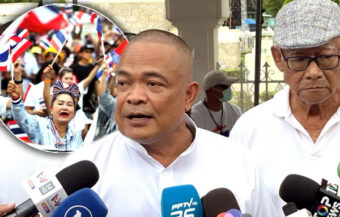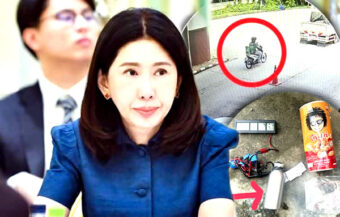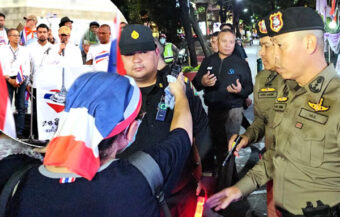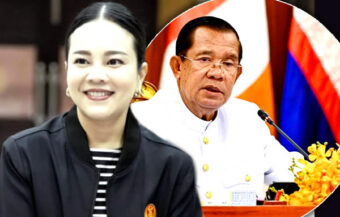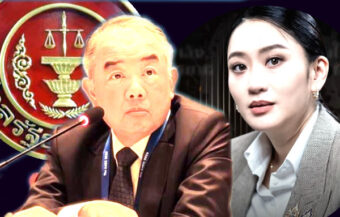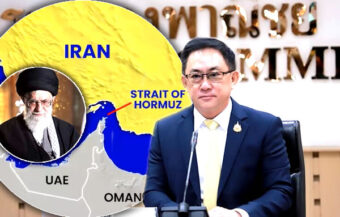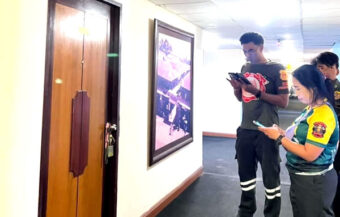Prime Minister Srettha Thavisin returned from the World Economic Forum (WEF) 2024 energised by ambitious plans for Thailand’s future. In particular, he appears focused on the land bridge initiative which was promoted by the cabinet on Monday in Ranong.
Prime Minister Srettha Thavisin has been busy this week promoting the land bridge initiative in southern Thailand. It comes with Mr Srettha, buoyed by interest in the project from potential international investors, visiting Ranong in Southern Thailand on Monday with a populist message of jobs and prosperity. The project’s white knights include Dubai Port World Company, a logistic and global trade pioneer. However, questions have arisen about the viability of the concept. In brief, a key study conducted in 2021 by Chulalongkorn University, concluded it is not a viable proposition as currently formulated.
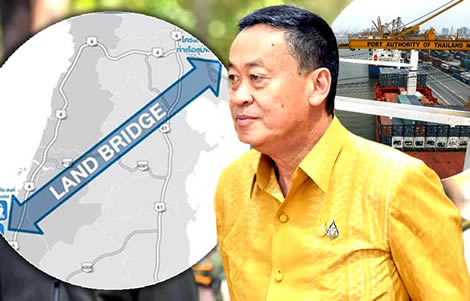
Prime Minister Srettha Thavisin returned from the World Economic Forum in Davos on Friday. At the start of the week, he travelled to southern Thailand. He was in the province of Ranong to push this land bridge initiative.
However, even as his spokesman Chai Wacharonke emphasised that the project was still just in its roadshow stage, reports of opposition to it were gathering.
Mr Chai highlighted that large potential investors had shown considerable interest. These include investors in Germany and Dubai. At the same time, he said the plans were being studied by port management experts.
Land bridge project received a key endorsement during the Prime Minister’s busy schedule last week in Davos, Switzerland where he targeted inward investment
However, on Monday, as the PM viewed plans for the project with local people, his enthusiasm for the scheme was infectious. He described it as doing something economically for local people.
Opposition to it is emerging based on its viability and cost-effectiveness.
During his Davos meetings, Prime Minister Srettha engaged with various investors and global leaders.
At length, his emphasis was on the importance of Thailand in international trade. The PM was looking to generate badly needed inward investment.
Thai PM and top leaders fly the flag at Davos as IMF says AI benefits wealthier countries far more
The World Economic Forum discussion group held an impressive 19 meetings, underlining the commitment to fostering economic growth. On his return on Friday, Srettha explained: ‘It was a heavy schedule, but it was beneficial to everyone who went.’
The PM heralded the trip to Davos as a success. In particular, Google, the tech giant, confirmed substantial investments in Thailand.
PM’s spokesman says there are now 20 potential investors or operators interested in the mega project
Significantly, the biggest outcome of the trip was an endorsement of the land bridge project.
At this time, government spokesman Chai says that 20 serious players have expressed an interest in the mammoth project.
In short, the land bridge initiative aims to create a logistics network connecting the Gulf of Thailand with the Andaman Sea. The project involves deep-water ports, a motorway, and a railway system, and comes with an estimated cost of ฿1 trillion.
Despite opposition concerns about the project’s size and cost-effectiveness, Prime Minister Srettha exuded confidence.
On Monday, in Ranong, he emphasised the potential benefits for the entire southern region.
The land bridge aims to alleviate congestion in the Straits of Malacca, a crucial global trade route. Srettha declared: ‘Constructing a mega project that links the Gulf of Thailand and the Andaman Sea to the world is important to lessen congestion.’
Dubai Port World Company’s interest has made many sceptical parties in Thailand sit up and take notice. Its representatives will visit Thailand in February
The project’s credibility was boosted further when Dubai Port World Company (DP World), a global logistics firm, expressed interest. The Prime Minister welcomed this with enthusiasm.
Finally, he confirmed that DP World’s representatives would visit Thailand for discussions and site surveys in February.
Before this news came during the week, the project had been considered by sceptics as a pipedream. Many in Thailand still consider it so.
In response to criticism and concerns, Srettha’s team are emphasising the project’s early stage. They point to the need for more public hearings and environmental impact studies.
The PM acknowledged the importance of communication with all stakeholders. Especially those who oppose the project. Prime Minister Srettha says the goal is to ensure transparency and inclusive decision-making.
Scale of the project questioned as well as its inherent viability by a 2021 Chulalongkorn University study commissioned by the country’s economics agency
Chulalongkorn University researcher Sompong Sirisoponsil cautioned that the project’s immense size might make investors cautious.
He suggested that investors could seek adjustments or more favourable conditions, raising questions about the project’s financial feasibility.
The university was called upon to review Thailand’s transport and logistics infrastructure in 2021.
Following this review, it dismissed the land bridge project as too extensive and unlikely to attract customers.
Basically, a key impediment was the cumbersome and expensive process of unloading and reloading cargo.
In short, the land bridge scheme means shippers unload their cargo at Ranong or Chumphon. Afterwards, they would be required to transport them 90 km from Ranong to Chumphon or vice versa.
Eventually, in Chumphon or Ranong Port after coming off the land bridge, they would have to reload the cargo again.
In effect, this will cost money, create added security risks and take time.
Shipping and freight firms gave the land bridge the thumbs down in a 2021 study for the last government
In 2021, Chulalongkorn University also revealed that there appeared to be a lack of support from established shippers.
Presently, these shipping lines transport freight through the Malacca Straits.
The analysis was carried out after a request was received from the National Economic and Social Development Council (NESDC), the country’s main economic agency. Previously, the proposal was considered at length by the last government.
Then Minister of Transport, Saksayam Chidchob, had championed the project although in a less expensive framework.
The current plan envisions two deep waters ports with the capacity to handle 20 million containers a year. In contrast, Thailand’s largest deep-water port today, Laem Chabang, only handles 8 million a year.
In 2021, the planned land bridge was estimated to cost ฿300 billion. Formerly, it came as part of a plan that called for Thailand to create its own state shipping line.
Six days of expensive logistics on the 90 km landbridge versus an extra two days at sea. Certainly, this argument against the project is a compelling one
One of the key considerations of that plan was Thailand’s security in turbulent geopolitical waters.
Land Bridge to PM Srettha’s economic policy dreams on the agenda with a 2029 launch date
Thailand planning an infrastructural overhaul aimed at improving regional transport links to boost the economy
The key study finding was that the costs involved in the handling of goods on the land bridge were prohibitive.
In addition, it found that the process could take six days to a week. Meanwhile, the shipping firms would only manage to shave off two days by avoiding the Malacca Straits.
In its 2021 report, Chulalongkorn University suggested that 80% of shipping concerns carrying international freight would not use the facility. Lastly, it suggested a smaller market for goods transported from Thailand itself as well as Cambodia, Myanmar, Laos and Vietnam.
Questions about the strategy for the region
Chulalongkorn lecturer Mr Sompong also questioned whether the development was a strategic fit for the region. Previously, it had been earmarked for tourism, in particular health tourism.
‘We might not need a land bridge at all if we want to be a wellness hub. In that case, we need an airport,’ the academic disclosed.
On Monday, however, in Ranong, the Prime Minister and key cabinet members were actively promoting the landbridge project. It was portrayed as a money spinner for southern Thailand.
Emphatically, the talk was populist. It was all about bringing jobs, prosperity and higher income levels.
PM says the environmental impact of the plan and the views of local residents will be assiduously examined as the project moves forward from this initial phase
Nevertheless, concerns about environmental impacts were entertained. The government has ordered comprehensive studies.
Prime Minister Srettha assured the media that while the land bridge project could significantly boost the country’s economy, environmental and social impacts would be handled with care.
In short, this includes paying fair compensation to affected communities for land used.
Digital Wallet plan blown out of the water by corruption body on Tuesday warning of illegality
As the land bridge project advances, the government faces mounting scepticism. Politically, the risks for Strettha are rising.
It comes as his Digital Wallet plan was sunk last week by the National Anti-Corruption Commission (NACC). A second misjudgment could prove disastrous in terms of confidence.
On Tuesday, the PM’s press spokesman Mr Chai, insisted that the project has been well received by investors.
It was presented at the Asia-Pacific Economic Cooperation (APEC) Summit in San Francisco last year. After that, investors in Tokyo examined the land bridge scheme and later the project was pushed in Davos.
It is a key piece in the government’s investment roadshow which also visited Europe where German investors showed interest.
Srettha’s spokesman questions the negativity being expressed towards the project by Thailand’s media while foreign investors and devices are receptive
Chai briefed reporters that top-level investors and port management experts were studying the plan. Certainly, this is the first draft of the proposal in an overview. It could well change.
The Prime Minister’s spokesman questioned the negativity towards the project in the Thai media.
He said that no such criticisms had been heard abroad.
Eventually, he opined, the experts and the international investors can make up their own minds.
He pointed out that the Ministry of Transport was well aware of the environmental aspects of the project. Undoubtedly, it would carefully consider the impact of the plan on local people.
At the same time, it was a proposal that could generate enormous benefits for Thailand’s ailing economy. Previously, Srettha had earmarked a 2029 launch date for the scheme.
Mr Chai confirmed that as well as Dubai Port World Company, at least nineteen other significant parties were reviewing the project.
Join the Thai News forum, follow Thai Examiner on Facebook here
Receive all our stories as they come out on Telegram here
Follow Thai Examiner here
Further reading:
Land Bridge to PM Srettha’s economic policy dreams on the agenda with a 2029 launch date
Transport ministry looks at launching Thailand’s own shipping line to support economic growth
RCEP deal agreed as India opts out – busy Bangkok ASEAN summit concludes on a low-key

